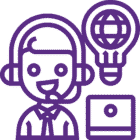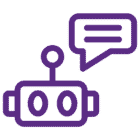In 1997, my parents graduated from college and began their professional careers at Charles Schwab, working in financial services as investment consultants. Though they had little experience, within two years, my parents were at the top of their department and generating significant revenue for the company. When I asked them about their quick and immediate success at Charles Schwab, they attributed it to Knowledge Management (KM), a concept that was certainly not new in the late 90s but had yet to gain industry recognition as a critical part of successful business operations.
As investment consultants, my parents were contacted by a variety of people looking for advice on how to handle their finances, from a small savings account to million dollar inheritances. These conversations with customers were usually over the phone, and it was my parents’ job to turn those quick calls into actual client leads. In order to answer difficult questions and sound like experts in the financial world, they depended on Charles Schwab’s intranet and internal help desk. This information database and direct access to human resources supplied employees with a wealth of knowledge in a time when the internet was brand new and most companies didn’t have websites to advertise their products and services.
Knowledge Management, in its simplest terms, is about connecting the right information to the right people at the right time. This concept is especially important in organizations where contact centers and help desks are a significant business function and employees with less experience may be speaking directly with potential clients or customers. Every employee in an organization, regardless of age or experience, should be equipped with the knowledge and tools they need to become an expert in their field and successfully communicate their company’s breadth of information and services to people who call in. In addition to the KM tools that will be detailed later in this blog, company leadership should prioritize and foster a culture of knowledge sharing, where information is routinely organized and shared in the correct channels and systems for enterprise-wide use.
Help desks are frequently the primary point of contact for customers who have questions about the company’s products or services. Given frequent turnover and a difficult hiring environment, companies struggle to hire and retain the most knowledgeable people for their help desks. This is a problem, but cannot be an excuse. If experts are not available to fill these positions, those employees who do receive the calls need direct access to use cases, platform permissions, step-by-step instructions, links, and everything else that would be required to resolve the customers’ problems.
Contact centers often serve a much broader purpose and are essentially a customer service department that handles customer complaints, orders, inquiries, etc. In this case, callers may already be frustrated, upset, or dissatisfied, making seamless access to the right information at the right time even more critical to deliver quality customer service.
Apart from the knowledge sharing culture and values that a strong KM foundation provides, there are several specific KM tools that we recommend for superior customer service in any of these business areas:
By establishing systematic and repetitive ways to deliver information to customers, an organization will possess consistent and positive customer experience as one of its key differentiators. Modern-day customers are used to digital self-service, but we all know how frustrating it can be to dial numbers over and over without ever finding a sufficient answer to a query. Until chatbots can entirely replicate human assistance, prioritizing Knowledge Management for contact centers and help desks will continue to improve customer service Key Performance Indicators (KPIs) and give service organizations a competitive advantage unlike any other.
Measuring customer service KPIs is a great way to quantify the effectiveness of KM in these parts of an organization. These KPIs can vary depending on the organization, but they include metrics like agent training time, agent errors, repeat calls, mean call time, resolution time, etc. Effective KM can help your organization lower customer service costs by reducing the time and efforts agents spend responding to customer inquiries, thereby building a strong business case for continued KM transformations. Are customer issues usually resolved during first contact? Are customers experiencing faster resolution times? Are agents prioritizing proactive development of self-service content based on common issues faced by customers? These are questions that KM stakeholders should seek answers to in order to identify service gaps in these departments and measure Return on Investment (ROI) from the implementation of the tools described above. These tools can be highly effective in improving these KPIs, and organizations should develop reporting that shows hard progress against these metrics to garner buy-in and support for KM efforts.
Once implemented, these tools can immediately begin demonstrating the benefits of KM for contact centers and help desks:
- Findability: With consistent and intuitive tagging of all content within a knowledge base, a call agent will be able to find direct answers to customer queries faster, easier, and more completely. A clear and easy user interface within a self-service portal will allow customers to quickly find answers to their questions and understand what an organization has to offer them.
- Consistency: Information governance is a key tenant of good KM. An organization should establish governance processes for its knowledge base to ensure content remains new, accurate, and complete for call agents’ reference, varying from content reviews to ownership to workflows. Here at EK, we have seen countless knowledge bases overrun with outdated and obsolete content, and good governance practices are the best way to counteract that trend.
- Collaboration: As mentioned before, a culture of knowledge sharing is a powerful way to ensure call agents and support staff are equipped for any customer question, even without the implementation of actual KM tools. Agents can work confidently knowing that they are surrounded by others who are willing to help and distribute knowledge in whatever way they can, adding another resource for agents who cannot immediately find what they are looking for in a knowledge base.
- Consumability: Structured content (that with predefined formats and organization) will be easy for agents to read, quickly understand, and then act upon. Good KM will ensure content is delivered to agents in the right format, scale, and scope for the situation, maximizing readability and minimizing cognitive load.
- Flexibility: Most of the time, an agent will need a quick and concise answer for a customer. However, in times when deeper answers are needed or desired, agents will have opportunities and resources to explore related content that is tagged similarly in the knowledge base.
- Supportability: Good KM dictates clear job roles and organizational structure. In more serious situations, agents will know when and to whom the situation should be escalated.
EK has experience with many projects of this nature, utilizing KM best practices to improve the efficiency of contact centers and help desks. One example is the work we did with the principal revenue collection agency of a national government overseas. In this engagement, the agency was having difficulty standardizing and managing content in their internal tool designed to guide service agents towards the correct information they need to support their customers. To help these service agents more easily locate content and navigate complex regulations and concepts, EK provided comprehensive Content Transformation Services which included Content Strategy and Governance Design. As a result of these efforts, the agency was positioned to standardize the way information is captured and managed across the enterprise, enabling content to become more findable, scannable, and intuitive to follow for service agents. Service agents spent less time finding applicable content within their internal tool, translating to a decrease in mean-time-to-resolve (MTTR) customer inquiries.
Overall, Knowledge Management in contact centers and help desks makes it smoother and more efficient for agents to find and use information. Customers expect and will often demand timely, personalized service; if these needs are not met, the organization will likely lose that customer. Every organization with a contact center or help desk must make sure their agents are equipped and empowered with the right knowledge and tools to correctly answer questions and provide relevant information. By investing in KM in these areas, your organization can ensure the satisfaction and longevity of both customers and employees. Here at EK, we offer many services to help organizations improve document management, content governance, search functionality, and so much more that can further the best practices detailed above. If you think your organization could benefit from Knowledge Management, contact us today to learn more about our services.



